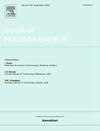基于多物理场耦合的三瓣燃料棒接触辐照力学行为研究
IF 2.3
3区 工程技术
Q1 NUCLEAR SCIENCE & TECHNOLOGY
引用次数: 0
摘要
流体领域的温度场和速度场是分析三瓣燃料棒力学性能的关键。因此,本研究利用ABAQUS-STAR CCM+建立了冷却剂单相流动、传热和燃料棒辐照力学的多物理场耦合模型。在燃料棒之间设置0.03毫米的间隙,以适应未辐照条件下的流体流动。然后,获得热参数,以研究与相邻杆接触时的应力应变和变形分布。结果表明,不同位置的横向速度与扭曲花瓣的搅拌效应有关。外凸弧逆时针方向受到内凹弧区域高温冷却剂的影响,传热系数较高。辐照增强可以降低塑性变形的风险,当燃耗达到初始金属原子裂变率(FIMA)的6.59%时,最大应变从0.0164降低到0.0015。受加热功率的影响,燃料棒沿轴向呈现不均匀的径向变形,导致相邻棒之间的接触状态发生变化。燃料棒的轴向伸长可以缓解这些接触区域的应力集中。本文章由计算机程序翻译,如有差异,请以英文原文为准。
Study on the irradiation mechanical behavior of three-petal fuel rods contact based on multi-physics field coupling
The temperature and velocity fields in the fluid domain are crucial for the analysis of the mechanical properties of three-petal fuel rods (TPFR). Therefore, this study establishes a multi-physics field coupling model of coolant single-phase flow, heat transfer and fuel rods irradiation mechanics using ABAQUS-STAR CCM+. A gap of 0.03 mm is set between the fuel rods to accommodate fluid flow under unirradiated conditions. Subsequently, the thermal parameters are obtained to investigate the stress–strain and deformation distribution, when in contact with adjacent rods. The results indicate that the transverse velocity at different positions is related to the churning effect of the twisted petals. The counterclockwise side of the outer convex arc is affected by the higher-temperature coolant from the inner concave arc region, resulting in a higher heat transfer coefficient. Irradiation enhancement can reduce the risk of plastic deformation, when the burnup reaches 6.59 % fissions of initial metal atoms (FIMA), the maximum strain decreases from 0.0164 to 0.0015. Influenced by the heating power, the fuel rods exhibit non-uniform radial deformation along the axial direction, leading to varying contact states between adjacent rods. Axial elongation of the fuel rods can alleviate stress concentrations in these contact regions.
求助全文
通过发布文献求助,成功后即可免费获取论文全文。
去求助
来源期刊

Annals of Nuclear Energy
工程技术-核科学技术
CiteScore
4.30
自引率
21.10%
发文量
632
审稿时长
7.3 months
期刊介绍:
Annals of Nuclear Energy provides an international medium for the communication of original research, ideas and developments in all areas of the field of nuclear energy science and technology. Its scope embraces nuclear fuel reserves, fuel cycles and cost, materials, processing, system and component technology (fission only), design and optimization, direct conversion of nuclear energy sources, environmental control, reactor physics, heat transfer and fluid dynamics, structural analysis, fuel management, future developments, nuclear fuel and safety, nuclear aerosol, neutron physics, computer technology (both software and hardware), risk assessment, radioactive waste disposal and reactor thermal hydraulics. Papers submitted to Annals need to demonstrate a clear link to nuclear power generation/nuclear engineering. Papers which deal with pure nuclear physics, pure health physics, imaging, or attenuation and shielding properties of concretes and various geological materials are not within the scope of the journal. Also, papers that deal with policy or economics are not within the scope of the journal.
 求助内容:
求助内容: 应助结果提醒方式:
应助结果提醒方式:


